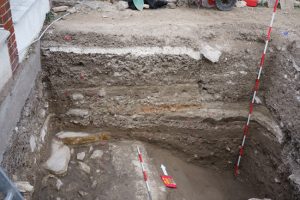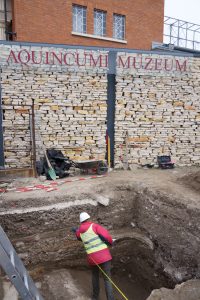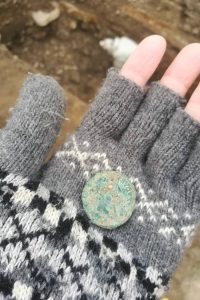While ancient Roman roads have become somewhat of a byword for eternal life (certain extant parts of the limes road are indeed in a remarkably good condition), a dig in the Aquincum Museum car park has revealed that at least this particular road was repaired frequently in antiquity.
Excavators led by archaeologist Orsolya Láng, the director of the Aquincum Museum, opened a trench measuring less than 3m by 3m in the museum’s car park. The reason for the dig was that this area – at the intersection of the Szentendrei út fence and the structure indicating the line of the ancient town wall – will be the site of the Aquincum Museum’s new visitor entrance, which will also have a service shaft. While construction will only begin in 2019, for planning reasons it was already necessary to excavate, given that we expected to find remains here of the Roman road connecting Aquincum’s Civil and Military Towns.
And as expected, less than a mere half metre below the modern street level, we were able to identify the latest surface of the road, from the second half of the 3rd century. While the small size of the excavated surface made it difficult to identify the individual periods – after all, it can be complicated to tell apart the individual surface and a subsequent pothole and road repair – it is certain that the road was repaved repeatedly. This resulted in nearly half-a-metre of fill and stone surfaces on top of the road’s earliest surface from the early 2nd century. The Roman road was likely some 6-7 metres wide and slanted slightly from the middle towards both sides to cast off the rain. On its eastern side, a small pavement had been identified previously. The road ran through the Aquincum Civil Town. When the town’s gates were closed for the night – to prevent through traffic – travellers thus stranded could take shelter in buildings, for instance an inn, outside the town walls, on the site of the present-day car park.
During the excavation, we could identify the earliest paved road, on which the later surfaces too were constructed. We also found a coin from the first decades of the 2nd century, which verified the dating of the layer.
Following the dig, the trench will be reburied temporarily, awaiting construction next year. According to the plans, the newly-unearthed section of the road will be marked at the new entrance.
The article and the photographs originally appeared on regeszet.btm.hu (in Hungarian).
Click here to read the previous entries of the Aquincum Museum’s blog.





